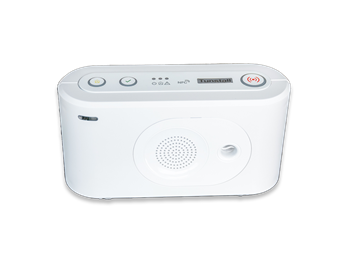Planning partnership
We started preparing for the digital transition almost three years ago. Our service is vital, so we wanted as much planning time as possible, and the ability to do more than just make sure our equipment would work. We wanted to really understand how to make the most of the digital switch and how that could change our service model and benefit our team and our service users. It also enabled us to phase our investment, and be more sure of securing the technology equipment we needed at a time when all telecare services would be looking to achieve the same thing. Tunstall gave us a lot of support as we developed our strategy, giving us a range of purchase options and helping us to align our budget with our deployment plan.
Our approach was to gradually replace analogue Lifeline home units with digital-ready units. All new installations (from June 2023) use Lifeline Digital, and if we undertake any service visits, we also take the opportunity to replace the existing unit with a Lifeline Digital. So, although we haven’t had a specific programme in place to swap out all analogue units, we’ve included it in our normal operations and this has worked really well for us. We’re making very good progress with an average of 200 installed per month, and we hope to have replaced almost all units by the close of 2024, well ahead of the estimated completion of the move to digital at the end of 2025.

Sounds great
We’ve seen a number of advantages to using Lifeline Digital, over and above ensuring our service users don’t experience any disruption as the UK moves to a digital network. The clarity of the audio is superb, which makes it easier and quicker for us to make sure the right response is given to each call, and each unit can be set to use one of 15 volume levels.
We use the DMP (Device Management Platform) to programme and manage units remotely; much of our maintenance work such as adjusting timers can now be done from the office, rather than having to physically go to the unit, which is obviously a massive time saver. We’ll also be moving from installing physical property exit sensors to using a PIR with a universal controller, which will mean we can adjust these settings remotely too.
Bright idea
A great feature of the Lifeline Digital is that it’s status lights can be configured to dim between certain hours, so although the lights are still easily visible, they are less intrusive in the dark. Our Lifeline Digital units are all programmed to dim between 7.00pm and 7.00am, and this seems to have made service users more comfortable to leave them connected to power overnight, where previously it wasn’t uncommon for users to switch equipment off at the plug when they went to bed.

Good call
We’ve worked with Tunstall for many years, and have recently moved our monitoring service back to Tunstall Response. They handle our calls, using our procedures, and liaise with our Responder service, and our team manages installation and administration. Calls are being answered much more quickly than with our previous hosted service, improving the service user experience, and complaints have reduced from several a day to zero. It’s a very successful collaboration, especially when it comes to newer initiatives such as our work with the ambulance service to try to reduce the number of call outs to falls where there is no need for hospital treatment.
As we all know, the NHS is under incredible pressure all year round, not just in winter, so working together using technology to help to target resources where they are needed most will benefit us all. The digital future will only bring further opportunities for efficiencies and increased integration, and it will be exciting to see what the next five years holds for services like ours.




